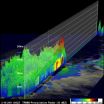(Press-News.org) Scientists have long been aware of a link between naval sonar exercises and unusual mass strandings of beaked whales. Evidence of such a link triggered a series of lawsuits in which environmental groups sued the U.S. Navy to limit sonar exercises to reduce risk to whales. In 2008, this conflict rose to the level of the US Supreme Court which had to balance potential threat to whales from sonar against the military risk posed by naval forces inadequately trained to use sonar to detect enemy submarines. The court ruled that the Navy could continue training, but that it was essential for the Navy to develop better methods to protect the whales.
The knowledge most critical to protecting these whales from risk of sonar involves measuring the threshold between safe and risky exposure levels, but until now it has not been known how beaked whales respond to sonar, much less the levels that pose a problem. "We know so little about beaked whales because they prefer deep waters far offshore, where they can dive on one breath of air to depths of over a mile for up to an hour and a half," said Peter Tyack, a senior scientist at Woods Hole Oceanographic Institution (WHOI).
Now, an international team of researchers reports in a paper led by Tyack the first data on how beaked whales respond to naval sonar exercises. Their results suggest that sonar indeed affects the behavior and movement of whales.
Tyack and his colleagues used two complementary methods to investigate behavioral responses of beaked whales to sonar: "an opportunistic approach that monitored whale responses to multi-day naval exercises involving tactical mid-frequency sonars, and an experimental approach using playbacks of simulated sonar and control sounds to whales tagged with a device that records sound, movement, and orientation," the researchers report in the current issue of the journal PLOS (Public Library of Science) ONE
That research team developed experiments to slowly increase the level of sonar at a tagged whale, to stop exposure as soon as the whale started responding, to measure that exposure, and to define the response. The experimental approach used tags to measure acoustic exposure and behavioral reactions of beaked whales to one controlled exposure each of simulated military sonar, killer whale calls, and band-limited noise.
"These experiments were very difficult to develop, and it was a major breakthrough simply to be able to develop a study that could safely study these responses," Tyack said. "All three times that tagged beaked whales were exposed experimentally to playback of sounds when they were foraging at depth, they stopped foraging prematurely and made unusually long and slow ascents to the surface, moving away from the sound.
Beaked whales use their own biosonar to find prey when they are foraging; this means that one can monitor cessation of foraging by listening for when they stop clicking. Once the researchers found that beaked whales responded to sonar by ceasing clicking, they were able to monitor reactions of beaked whales during actual sonar exercises on the range. The research was conducted on a naval testing range where an array of underwater microphones, or hydrophones, covered the seafloor, allowing whale sounds to be monitored over 600 square miles. "During actual sonar exercises, beaked whales were primarily detected near the periphery of the range, on average 16 km away from the sonar transmissions. Once the exercise stopped, beaked whales gradually filled in the center of the range over 2-3 days," they report.
A satellite tagged whale moved outside the range during an exercise, returning over 2-3 days post-exercise. "The combined results indicate similar disruption of foraging behavior and avoidance by beaked whales in the two different contexts, at exposures well below those used by regulators to define disturbance," the scientists report.
"This suggests that beaked whales are particularly sensitive to sound. Their behavior tended to be disrupted at exposure levels around 140 decibels (dB), so they may require a lower threshold than many current regulations that anticipate disruption of behavior around 160 dB, " said Tyack. "But the observations on the naval range suggest that while sonar can disrupt the behavior of the whales, appropriate monitoring and management can reduce the risk of stranding."
###The research was supported by the United States Office of Naval Research, the U.S. Strategic Environmental Research and Development, the Environmental Readiness Division of the U.S. Navy, the U.S. Chief of Naval Operations Submarine Warfare Division (Undersea Surveillance), NOAA and the Joint Industry Program on Sound and Marine Life of the International Association of Oil and Gas Producers. The funders had no role in study design, data collection and analysis, decision to publish, or preparation of the manuscript.
The Woods Hole Oceanographic Institution is a private, independent organization in Falmouth, Mass., dedicated to marine research, engineering, and higher education. Established in 1930 on a recommendation from the National Academy of Sciences, its primary mission is to understand the ocean and its interaction with the Earth as a whole, and to communicate a basic understanding of the ocean's role in the changing global environment.
WHOI-led report links sonar to whale strandings
2011-03-18
ELSE PRESS RELEASES FROM THIS DATE:
2 new SCAP documents help improve automating computer security management
2011-03-18
It's increasingly difficult to keep up with all the vulnerabilities present in today's highly complex operating systems and applications. Attackers constantly search for and exploit these vulnerabilities to commit identity fraud, intellectual property theft and other attacks. The National Institute of Standards and Technology (NIST) has released two updated publications that help organizations to find and manage vulnerabilities more effectively, by standardizing the way vulnerabilities are identified, prioritized and reported.
Computer security departments work behind ...
LateRooms.com - Head to Naples for The Aesthetics of Mould
2011-03-18
The Aesthetics of Mould is a new art exhibition in Naples that examines the creative process and compares it to the way nature evolves.
Running from March 25th to April 30th 2011, it will see the work of the production duo Ttozoi displayed at the Piazza S Eframo Vecchio.
The strange and captivating images created by the artists are very modern in their approach, but lean heavily on movements such as Gutai and abstract expressionism.
According to the organisers, the art on show is a perfect example of how a piece is born when the creator finishes painting it, but ...
NASA satellites show towering thunderstorms in rare sub-tropical storm Arani
2011-03-18
NASA's Aqua and TRMM satellites are providing data to scientists about the Southern Atlantic Ocean Sub-tropical Storm Arani, a rare occurrence in the southern ocean. Rainfall data and cloud top temperatures revealed some heavy rain and strong thunderstorms exist in Arani as it continues to pull away from Brazil.
NOAA's Satellite and Information Service classified Arani as a T1 on the Dvorak intensity scale which would indicate an estimated wind speed of about 29 knots (~33 mph).
During the daytime on Tuesday, March 15 at 1820 UTC (2:20 p.m. EST) NASA's Tropical Rainfall ...
Physicists move closer to efficient single-photon sources
2011-03-18
Washington, D.C. (March 16, 2011) -- A team of physicists in the United Kingdom has taken a giant step toward realizing efficient single-photon sources, which are expected to enable much-coveted completely secure optical communications, also known as "quantum cryptography." The team presents its findings in Applied Physics Letters, a journal published by the American Institute of Physics.
Fluorescent "defect centers" in diamond act like atomic-scale light sources and are trapped in a transparent material that's large enough to be picked up manually. They don't need to ...
'Pruned' microchips are faster, smaller, more energy-efficient
2011-03-18
GRENOBLE, France -- (March 16, 2011) -- An international team of computing experts from the United States, Switzerland and Singapore has created a breakthrough technique for doubling the efficiency of computer chips simply by trimming away the portions that are rarely used.
"I believe this is the first time someone has taken an integrated circuit and said, 'Let's get rid of the part that we don't need,'" said principal investigator Krishna Palem, the Ken and Audrey Kennedy Professor of Computing at Rice University in Houston, who holds a joint appointment at Nanyang Technological ...
New study pinpoints why some microbial genes are more promiscuous than others
2011-03-18
Durham, NC — A new study of more than three dozen bacteria species — including the microbes responsible for pneumonia, meningitis, stomach ulcers and plague — settles a longstanding debate about why bacteria are more likely to steal some genes than others.
While most organisms get their genes from their parents just like people do, bacteria and other single-celled creatures also regularly pick up genes from more distant relatives. This ability to 'steal' snippets of DNA from other species — known as lateral gene transfer — is responsible for the rapid spread of drug resistance ...
LateRooms.com - Experience the Passion of Belen Maya in Seville
2011-03-18
There is a treat in store for flamenco enthusiasts spending time in Seville next month, as critically acclaimed dancer and choreographer Belen Maya is going to take the stage.
She will perform a piece entitled CIA with Olga Pericet, accompanied by singers and guitarists.
The show will take place on April 5th at the Teatro Lope de Vega and its tagline translates as 'joyful dances for sad people'.
Maya is the daughter of renowned flamenco performer Mario Maya, who passed away in 2008, but she has carved out a reputation of her own.
Born in New York, she started ...
Does your name dictate your life choices?
2011-03-18
What's in a name? Letters. And psychologists have posited that the letters—particularly the first letter of our names—can influence decisions, including whom we marry and where we move. The effect is called "implicit egotism."
In 2008, two Belgian researchers found that workers in their country were more likely to choose a workplace if the first letter of its name matched their own.
A commentary published in an upcoming issue of Psychological Science, a journal of the Association for Psychological Science, revisited the study with similar U.S. data and found that the ...
Innovative technique gives vision researchers insight into how people recognize faces
2011-03-18
Rockville, MD — It is no surprise to scientists that the largest social network on the web is called Facebook. Identifying people by their face is fundamental to our social interactions, one of the primary reasons vision researchers are trying to find out how our brain processes facial identity.
In a study recently published in the Journal of Vision, scientists used an original approach — a method that "shakes" the brain gently and repeatedly by making an image appear and disappear at a constant rate — to evaluate its sensitivity to perceiving facial identity. The technique ...
NASA's Aqua Satellite spies a '3-leaf Clover' view of Ireland for St. Patrick's Day
2011-03-18
Typical clovers have three leaves, unless you happen to be lucky, and NASA's Aqua satellite has provided three different views of Ireland to mark Saint Patrick's Day on March 17, 2011. With the luck o' the Irish, NASA's Aqua satellite was fortunate to capturemostly clear views of the Emerald Isle in these near-infrared/visible, infrared and microwave light views acquired by Aqua's Atmospheric Infrared Sounder (AIRS) instrument on March 3, 2011, at 13:11 UTC.
Ireland, located in the Atlantic Ocean, is the third-largest island in Europe, and originated the St. Patrick's ...

